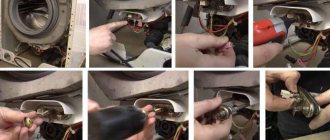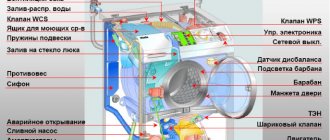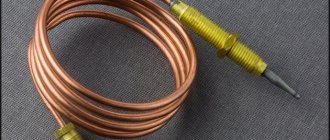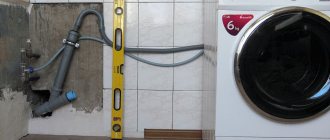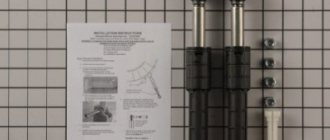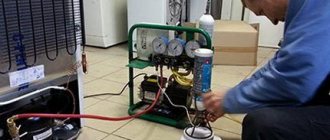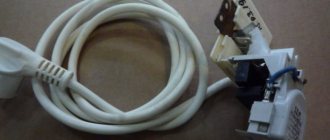In matters of restoring the technical capabilities and performance of household appliances, we are accustomed to relying on service centers. However, not all breakdowns require the intervention of a specialist. Many minor problems can be easily fixed with your own hands.
One typical example is repairing washing machine shock absorbers, which you can do yourself. We will tell you how to dismantle worn parts of the shock absorption system and install new elements. Our recommendations will help you quickly and efficiently restore the operation of your washing machine.
Typical causes of breakdowns
Depending on the settings, the brand of the unit and the functions performed, the washing machine drums make from 700 to 1800 revolutions per minute. Such an impressive load, and even with the application of rotational force, can easily damage contacting parts and weaken components and connections.
If shock absorbers had not been developed to dampen the vibration of the drum and the tank containing it during the spin period, the machine would have to be repaired after each washing “session”. Their purpose is no different from the functions of similar car devices.
Shock-absorbing devices of washing machines perform work equivalent to similar parts of cars. They are designed to dampen the vibrating movements of the tank during the spinning/washing process (+)
Shock absorbers, coupled with suspension springs, eliminate direct contact between the machine’s tank and its metal body, steel and plastic parts. In the form of original supports, they are located under the main rotating part of the equipment, which is fixed in the upper part of the unit by hanging springs.
During operation of the washing machine, the supports and springs are unstable, due to which the drum, rotating at breakneck speed, can slightly shift relative to its resting position.
Those. These devices, performing spring movements, provide the drum with the ability to make the required rotations according to its status, without transferring the load to adjacent parts and assemblies.
The tank of the washing unit is suspended from above using springs, from below it rests on shock absorbers or dampers, which prevent the transmission of vibration from the drum to the body of the machine
The structural components of the washing machine, protected from vibration by shock absorbers, last much longer and are less likely to fail. True, the shock-absorbing devices themselves gradually lose their original strength during the execution of the assigned task.
Worn-out devices may require repair or replacement at an extremely inopportune moment, for example, before an evening wash, the timing of which does not allow calling a technician urgently. Or we will have to wait quite a long time for his arrival. This is where you will need information about the specifics of restoring shock absorbers and their structure.
If there is an urgent need to repair shock absorbers, work on their repair or replacement can be done with your own hands
The device of spring shock absorbers
One of the most common types of shock absorbers for washing equipment has the so-called spring-piston design. To put it in exaggerated terms, it is a metal cylinder with a polymer sleeve at the top. It directs the movement of the rod installed in the shock absorber.
The upper part of the rod is “sharpened” to fit polymer liners and rubber gaskets, with the help of which it is connected to the drum. Attached to the base of the rod is a piston with a gasket heavily impregnated with non-drying lubricant. This lubricant is needed to increase the friction force when the rod and piston move through the cavity of the steel cylinder.
The main structural components of a spring-piston shock absorber include a metal cylinder, closed at the top by a bushing, and a polished rod with a piston
The operation of a spring-piston type shock absorber includes a number of sequentially repeated actions:
- During sudden vibrations, the shock absorber rod is set into linear motion.
- The piston pressed by the rod moves along the cylinder cavity.
- Impregnation prevents the piston from slipping without appropriate force.
- When the pressure is released, the rod returns to its original position.
- When effort arises, everything repeats.
To ensure that the air in the cylinder does not create additional resistance, the piston is perforated. When you press on it, a possible air lock can easily come out through the holes made through it.
The load that appears during rotation of the drum puts pressure on the rod, which in turn pushes the piston fixed at its base along the steel cylinder
Of course, such a mode of operation does not give reason to hope for the eternal preservation of parts rubbing against each other in their original technical condition. At first, just play appears, then wear. Moreover, only one spring support can be damaged, and there are 2 to 4 of them in different modifications of washing units.
To remove the air plug located inside the cylinder, holes are made in it (Fig. on the left). At the top, the shock absorber rod is equipped with a seat for rubber gaskets and polymer inserts, through which it is attached to the washing machine tank
The operating principle of shock absorbers for washing machines of different brands is similar, but there are some design nuances. Their size, angle of inclination, location may differ; not in all models of washing equipment they are supplemented with springs holding the drum on top.
Instead of a pair of suspensions located on top, small springs can be used, connected to a nearby upper counterweight.
In other layout options, the tank, consisting of two parts, is supported by dampers from below instead of shock absorbers. This design type is classic, therefore it is also very worth understanding the structure of these devices. It is possible that this is exactly your case.
The motor in the modification of the washing machine shown in the diagram is mounted at the top. There is no need to disassemble it completely to replace shock absorbers; just remove the side or rear part of the body
Design features of dampers
Dampers in washing machines are also used in combination with suspension springs, but their structure does not contain elements that are not very strong. In fact, this is also a steel cylinder, although it is not a rod with a piston that moves through its cavity, but simply a piston with holes in the walls to remove excess air.
The damper piston is also equipped with a friction-type gasket. It is made of porous polymer and impregnated with a non-drying lubricant that creates additional friction. There can be two or even more gaskets in the damper, it all depends on the characteristics of the device.
Both the metal cylinder and the damper moving along its cavity are equipped with rubber bushings on the outer edges, with the help of which the shock-absorbing devices are connected to the bottom of the machine and to the tank.
The damper has two main components: a piston equipped with a friction pad, and a steel cylinder in which the piston moves
Dampers are available in two versions:
- Collapsible. To repair this type, most often it is enough to simply replace the pressed gasket.
- Non-separable. Their edges are rolled. Repair of this type consists of replacing the device.
The values of the maximum permissible force possible for a particular shock-absorbing device are indicated on the damper or shock absorber housings. Typically the load varies in the range of 50 - 150 newtons. When operating in the manufacturer-guaranteed mode, washers rarely exceed these limits.
When buying a new shock-absorbing device for replacement, you should not exceed the characteristics indicated on the previous part. If 100 N is indicated on the case, then there is no need to delude yourself that an element with 150 N will last longer; you need to purchase exactly the same one or with similar indicators.
There is a motor attached to the bottom of the tank on the side; it and other components will need to be removed before removal to replace the dampers.
Making a new gasket for the damper
If noise and significant knocking are detected in a washing machine with dampers, it is often enough to change the sealing gaskets. To do this, you need to partially disassemble the machine and simply disconnect the device.
Then, according to plumbing rules, you should simply cut out new gaskets from textolite or a piece of rubber of suitable thickness. After which the gaskets are replaced.
Only dismountable damper versions can be repaired. In most cases, it is simply necessary to replace the gaskets and bushings used in the connections between the device and the tank and the bottom of the unit
A used rubber brake pad for a car is ideal as a starting material for making your own gaskets. It is better to select the rubber thickness according to the actual size of the gap between the tank and the shock-absorbing device.
READ MORE: TOP 7. The best electric scooters of 2021. Rating for June!
Diagnosis of typical faults
Shock-absorbing devices of washing machines belong to the mechanical part of household equipment. Their repair and replacement do not require fundamental knowledge in the field of electrical or even mechanics. This means that even the intervention of an amateur will not be able to cause serious damage.
Please note that unique technical documentation is issued for each model of washing unit. Service techniques are usually authorized and devices are patented. However, there are methods for repairing shock-absorbing devices that are common to almost all types of washing machines, the specifics of which are worth understanding.
The appearance of typical damage to shock absorbers or dampers will be signaled by a specific noise that occurs during operation of the machine, or too much knocking inside its body.
Symptoms of damage or wear of the shock absorber are unusual noise during washing/spin, strong knocking, excessively active vibration with body distortions
If alarming sounds are detected, their condition should be examined, and for this you need to provide yourself with access to the devices being tested. Depending on the model, for the examination you will need to remove either the top panel, the side panel, or the back panel.
Methods for diagnosing shock absorbers for washing equipment depend on the type of load:
- From the front. If, when applying force to the tank from above, folds form on the sealing collar of the loading hatch, the shock absorbers must be replaced. By the way, you can also notice a couple of folds while the machine is operating with worn-out accessories.
- From vertical. If, when applying force to the tank from above, no resistance is felt, and the tank, after interrupting the pressure, continues to swing like a pendulum, it needs to be repaired.
When carrying out diagnostics with top loading, you must definitely pay attention to how much the tank sags when pressed, if the indicated defect occurs. It would be nice to track the fact of sagging and its conditional value with a full tank load.
The signal to replace the shock absorbers will be the folds on the sealing collar, which often has to be changed no less often than the shock absorbers themselves
It is imperative to check whether there is at least some reserve for the reciprocating movement of the tank of the washing machine being examined. If it sags so that there is simply no room left for it to move during vibration, then a loud knock will occur during washing or spinning. And this is a sure sign of damage to the tank in the near future, and simply imbalance.
In normal technical condition, front-loading washing machines should not have cuff folds at all, regardless of the function being performed. Note that the formation of a single fold on this rubber seal indicates that only one of the shock absorbers is damaged.
If the folds on the cuff of the washer do not indicate damage to the shock absorbers, it means that it is worn out or deformed from the use of substances undesirable for its structure. In this case, the seal should be replaced.
In normally functioning units with a top load, if the shock-absorbing devices are not damaged, after applying force to the tank from above and abruptly interrupting the load, i.e. retracting the hand, the tank should smoothly return to its original place without excessive swinging and vibration.
If the dampers of the washing machine are damaged, then this can be determined by the cuff even with a minimum load of the drum. The presence of two folds in the seal indicates that two devices require repair or replacement
Replacement procedure
Let's find out how to replace the shock absorbers of a washing machine with your own hands. You will need a screwdriver and a set of wrenches. First you need to get easy access to them. On some models, simply remove the back cover. If your shock absorbers are located in the front, then you will need to complete the following points:
- Remove the bolts and then remove the top cover of the washing machine.
- Remove the powder receptacle and the bottom plastic panel. Be careful! Do not damage the wires.
- Remove the cuffs and release the metal clamps.
- Unscrew all the bolts by removing the front part of the machine.
- Remove the wires or the door lock completely.
- Dismantle the façade of the building.
- At the bottom of the machine on the sides there are shock absorbers. Unscrew the bolt that secures the element to the body or remove the latch (depending on the specific model).
- Disconnect the shock absorber from the tank in the same way as described above.
- Install the new part and then reassemble in reverse order.
In the worst cases, it will be structurally impossible to disconnect the shock absorber from the tank. Then you just have to completely remove the tank. This is a rather complicated procedure. If you do not want to cause additional damage, contact a professional. When purchasing new parts, it is recommended to pay attention to the article numbers to be sure that the product is compatible with the model of your machine.

